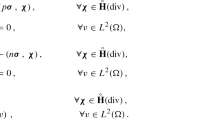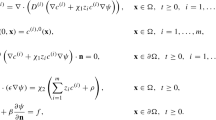Abstract
In this article, we propose and analyze a fully coupled, nonlinear, and energy-stable virtual element method (VEM) for solving the coupled Poisson–Nernst–Planck (PNP) and Navier–Stokes (NS) equations. These equations model microfluidic and electrochemical systems that include the diffuse transport of charged species within incompressible fluids coupled through electrostatic forces. A mixed VEM is employed to discretize the NS equations whereas classical VEM in primal form is used to discretize the PNP equations. The stability, existence and uniqueness of solution of the associated VEM are proved by fixed point theory. The global mass conservation and electric energy decay of the scheme are also established. Also, we rigorously derive unconditionally optimal error estimates for both the electrostatic potential and ionic concentrations of PNP equations in the \(\textrm{L}^{2}\) and \(\textrm{H}^{1}\)-norms, as well as for the velocity and pressure of NS equations in the \(\textbf{L}^{2}\), \(\textbf{H}^1\)- and \(\textrm{L}^{2}\)-norms, respectively. Finally, several numerical experiments are presented to support the theoretical analysis of convergence and to illustrate the satisfactory performance of the method in simulating the onset of electrokinetic instabilities in ionic fluids, and studying how they are influenced by different values of ion concentration and applied voltage. These tests are relevant in applications of water desalination.








Similar content being viewed by others
Data Availability
Data sharing not applicable to this article as no datasets were generated or analysed during the current study.
References
Ahmad, B., Alsaedi, A., Brezzi, F., Marini, L.D., Russo, A.: Equivalent projectors for virtual element methods. Comput. Math. Appl. 66(3), 376–391 (2013)
Beirão da Veiga, L., Brezzi, F., Cangiani, A., Manzini, G., Marini, L.D., Russo, A.: Basic principles of virtual element methods. Math. Models Methods Appl. Sci. 23, 199–214 (2013)
Beirão da Veiga, L., Brezzi, F., Marini, L.D., Russo, A.: The Hitchhiker’s guide to the virtual element method. Math. Models Methods Appl. Sci. 24(8), 1541–1573 (2014)
Beirão da Veiga, L., Lovadina, C., Russo, A.: Stability analysis for the virtual element method. Math. Models Methods Appl. Sci. 27(13), 2557–2594 (2017)
Beirão da Veiga, L., Lovadina, C., Vacca, G.: Divergence free virtual elements for the Stokes problem on polygonal meshes. ESAIM Math. Model. Numer. Anal. 51(2), 509–535 (2017)
Beirão da Veiga, L., Lovadina, C., Vacca, G.: Virtual elements for the Navier–Stokes problem on polygonal meshes. SIAM J. Numer. Anal. 56(3), 1210–1242 (2018)
Beirão da Veiga, L., Mora, D., Vacca, G.: The Stokes complex for virtual elements with application to Navier–Stokes flows. J. Sci. Comput. 81(2), 990–1018 (2019)
Brenner, S.C., Guan, Q., Sung, L.Y.: Some estimates for virtual element methods. Comput. Methods Appl. Math. 17(4), 553–574 (2017)
Brezzi, F., Falk, R.S., Marini, L.D.: Basic principles of mixed virtual element methods. ESAIM Math. Model. Numer. Anal. 48(4), 1227–1240 (2014)
Bürger, R., Méndez, P.E., Ruiz-Baier, R.: On H(div)-conforming methods for double-diffusion equations in porous media. SIAM J. Numer. Anal. 57(3), 1318–1343 (2019)
Cáceres, E., Gatica, G.N.: A mixed virtual element method for the pseudostress-velocity formulation of the Stokes problem. IMA J. Numer. Anal. 37(1), 296–331 (2017)
Cangiani, A., Gyrya, V., Manzini, G.: The nonconforming virtual element method for the Stokes equations. SIAM J. Numer. Anal. 54(6), 3411–3435 (2016)
Cangiani, A., Manzini, G., Sutton, O.J.: Conforming and nonconforming virtual element methods for elliptic problems. IMA J. Numer. Anal. 37(3), 1317–1354 (2017)
Chen, L., Huang, J.: Some error analysis on virtual element methods. Calcolo 55(1), 23 (2018)
Choi, H., Paraschivoiu, M.: Advanced hybrid-flux approach for output bounds of electroosmotic flows: adaptive refinement and direct equilibrating strategies. Microfluid. Nanofluid. 2(2), 154–170 (2005)
Cioffi, M., Boschetti, F., Raimondi, M.T., Dubini, G.: Modeling evaluation of the fluiddynamic microenvironment in tissue-engineered constructs: a micro-CT based model. Biotechnol. Bioeng. 93(3), 500–510 (2006)
Correa, C.I., Gatica, G.N., Ruiz-Baier, R.: New mixed finite element methods for the coupled Stokes/Poisson–Nernst–Planck equations in Banach spaces. CI\(^2\)MA preprint (2022). Available from https://www.ci2ma.udec.cl/publicaciones
Correa, C.I., Gatica, G.N., Ruiz-Baier, R.: Banach spaces-based mixed finite element methods for the coupled Navier–Stokes and Poisson–Nernst–Planck equations. CI\(^2\)MA preprint (2023). Available from https://www.ci2ma.udec.cl/publicaciones
Dehghan, M., Gharibi, Z.: Virtual element method for solving an inhomogeneous Brusselator model with and without cross-diffusion in pattern formation. J. Sci. Comput. 89(1), 16 (2021)
Dreyer, W., Guhlke, C., Müller, R.: Overcoming the shortcomings of the Nernst–Planck model. Phys. Chem. Chem. Phys. 15(19), 7075–7086 (2013)
Druzgalski, C., Andersen, M., Mani, A.: Direct numerical simulation of electroconvective instability and hydrodynamic chaos near an ion-selective surface. Phys. Fluids 25, 110804 (2013)
Evans, L.C.: Partial Differential Equations, 2nd edn. American Mathematical Society, Providence (2010)
Fuhrmann, J., Guhlke, C., Merdon, C., Linke, A., Müller, R.: Induced charge electroosmotic flow with finite ion size and solvation effects. Electrochimica Acta 317, 778–785 (2019)
Fuhrmann, J., Guhlke, C., Linke, A., Merdon, C., Müller, R.: Models and numerical methods for electrolyte flows. In: Hintermüller, M., Rodrigues, J.F. (eds.) Topics in Applied Analysis and Optimisation, CIM Series in Mathematical Sciences, pp. 183–209. Springer, Berlin (2019)
Gao, H., He, D.: Linearized conservative finite element methods for the Nernst–Planck–Poisson equations. J. Sci. Comput. 72, 1269–1289 (2017)
Gao, H., Sun, P.: A linearized local conservative mixed finite element method for Poisson–Nernst–Planck equations. J. Sci. Comput. 77, 793–817 (2018)
Gatica, G.N., Munar, M., Sequeira, F.: A mixed virtual element method for the Navier–Stokes equations. Math. Models Methods Appl. Sci. 28(14), 2719–2762 (2018)
Gross, A., Morvezen, A., Castillo, P., Xu, X., Xu, P.: Numerical investigation of the effect of two-dimensional surface waviness on the current density of ion-selective membranes for electrodialysis. Water 11(7), 1397 (2019)
Galama, O.: Ion exchange membranes in seawater applications: processes and characteristics. Ph.D Thesis (2015)
Gharibi, Z., Dehghan, M., Abbaszadeh, M.: Numerical analysis of locally conservative weak Galerkin dual-mixed finite element method for the time-dependent Poisson–Nernst–Planck system. Comput. Math. Appl. 92, 88–108 (2021)
He, Y.: A fully discrete stabilized finite-element method for the time-dependent Navier–Stokes problem. IMA J. Numer. Anal. 23, 665–691 (2003)
He, W.-M., Guo, H.: Optimal maximum norm estimates for virtual element methods. SIAM J. Numer. Anal. 60(3), Article 3 (2022)
He, M., Sun, P.: Error analysis of mixed finite element method for Poisson–Nernst–Planck system. Numer. Methods Partial Differ. Equ. 33, 1924–1948 (2017)
He, M., Sun, P.: Mixed finite element analysis for the Poisson–Nernst–Planck/Stokes coupling. J. Comput. Appl. Math. 341, 61–79 (2018)
Heywood, J.G., Rannacher, R.: Finite element approximation of the nonstationary Navier–Stokes problem. I. Regularity of solutions and second-order error estimates for spatial discretization. SIAM J. Numer. Anal. 19, 275–311 (1982)
Hu, Y., Lee, J.S., Werner, C., Li, D.: Electrokinetically controlled concentration gradients in micro-chambers in microfluidic systems. Microfluid. Nanofluid. 2(2), 141–153 (2005)
Jerome, J.W.: Analytical approaches to charge transport in a moving medium. Transp. Theory Stat. Phys. 31, 333–366 (2002)
Jerome, J.W.: Consistency of semiconductor modeling: an existence/stability analysis for the stationary Van Boosbroeck system. SIAM J. Appl. Math. 45, 565–590 (1985)
Jerome, J.W.: The steady boundary value problem for charged incompressible fluids: PNP/Navier–Stokes systems. Nonlinear Anal. 74, 7486–7498 (2011)
Jerome, J.W., Chini, B., Longaretti, M., Sacco, R.: Computational modeling and simulation of complex systems in bio-electronics. J. Comput. Electron. 7(1), 10–13 (2008)
Karatay, E., Druzgalski, C.L., Mani, A.: Simulation of chaotic electrokinetic transport: performance of commercial software versus custom-built direct numerical simulation codes. J. Colloid Interface Sci. 446, 67–76 (2015)
Kim, S., Khanwalea, M.A., Anand, R.K., Ganapathysubramanian, B.: Computational framework for resolving boundary layers in electrochemical systems using weak imposition of Dirichlet boundary conditions. Finite Elem. Anal. Des. 205, e103749 (2022)
Linga, G., Bolet, A., Mathiesen, J.: Transient electrohydrodynamic flow with concentration-dependent fluid properties: modelling and energy-stable numerical schemes. J. Comput. Phys. 412, e109430 (2020)
Liu, X., Chen, Z.: The nonconforming virtual element method for the Navier–Stokes equations. Adv. Comput. Math. 45(1), 51–74 (2019)
Liu, Y., Shu, S., Wei, H., Yang, Y.: A virtual element method for the steady-state Poisson–Nernst–Planck equations on polygonal meshes. Comput. Math. Appl. 102, 95–112 (2021)
Lu, B., Holst, M., McCammon, J., Zhou, Y.: Poisson–Nernst–Planck equations for simulating biomolecular diffusion–reaction processes I: finite element solutions. J. Comput. Phys. 229, 6979–6994 (2010)
Mauri, A., Bortolossi, A., Novielli, G., Sacco, R.: 3D finite element modeling and simulation of industrial semiconductor devices including impact ionization. J. Math. Ind. 5, e18 (2015)
Nirenberg, L.: An extended interpolation inequality. Ann. Scuola Norm. Sup. Pisa 20(3), 733–737 (1966)
Park, J.-H., Jerome, J.W.: Qualitative properties of steady-state Poisson–Nernst–Planck systems: mathematical study. SIAM J. Appl. Math. 57(3), 609–630 (1997)
Prohl, A., Schmuck, M.: Convergent discretizations for the Nernst–Planck–Poisson system. Numer. Math. 111, 591–630 (2009)
Prohl, A., Schmuck, M.: Convergent finite element discretizations of the Navier–Stokes–Nernst–Planck–Poisson system. ESAIM Math. Model. Numer. Anal. 44, 531–571 (2010)
Ryham, R.J.: An energetic variational approach to mathematical modeling of charged fluids: charge phases, simulation and well posedness. Doctoral dissertation, The Pennsylvania State University (2006)
Schmuck, M.: Analysis of the Navier–Stokes–Nernst–Planck–Poisson system. Math. Models Methods Appl. Sci. 19(6), 993–1015 (2009)
Vacca, G., Beirão da Veiga, L.: Virtual element methods for parabolic problems on polygonal meshes. Numer. Methods Partial Differ. Equ. 31(6), 2110–2134 (2015)
Verma, N., Kumar, S.: Virtual element approximations for non-stationary Navier–Stokes equations on polygonal meshes. J. Appl. Anal. Comput., in press (2022)
Wang, C., Bao, J., Pan, W., Sun, X.: Modeling electrokinetics in ionic liquids. Electrophoresis 00, 1–13 (2017)
Wang, G., Wang, F., He, Y.: A divergence-free weak virtual element method for the Navier–Stokes equation on polygonal meshes. Adv. Comput. Math. 47, e83 (2021)
Wei, H., Huang, X., Li, A.: Piecewise divergence-free nonconforming virtual elements for Stokes problem in any dimensions. SIAM J. Numer. Anal. 59(3), 1835–1856 (2021)
Xu, P., Capito, M., Cath, T.Y.: Selective removal of arsenic and monovalent ions from brackish water reverse osmosis concentrate. J. Hazard. Mater. 260, 885–891 (2013)
Xie, D., Lu, B.: An effective finite element iterative solver for a Poisson–Nernst–Planck ion channel model with periodic boundary conditions. SIAM J. Sci. Comput. 42(6), B1490–B1516 (2020)
Yang, Y., Liu, Y., Shu, S.: Error analysis of virtual element methods for the time-dependent Poisson–Nernst–Planck equations. ArXiv preprint (2022). Available from arXiv:2207.07231
Acknowledgements
The authors are very grateful to the anonymous reviewers for carefully reading this paper and for their comments and suggestions, which have improved the paper.
Funding
The research of the third author has been partially supported by the Monash Mathematics Research Fund S05802-3951284, by the Australian Research Council through the Future Fellowship Grant FT220100496 and Discovery Project Grant DP22010316, and by the Ministry of Science and Higher Education of the Russian Federation within the framework of state support for the creation and development of World-Class Research Centers Digital biodesign and personalized healthcare No. 075-15-2022-304.
Author information
Authors and Affiliations
Corresponding author
Ethics declarations
Conflict of interest
The authors have not disclosed any competing interests.
Additional information
Publisher's Note
Springer Nature remains neutral with regard to jurisdictional claims in published maps and institutional affiliations.
Rights and permissions
Springer Nature or its licensor (e.g. a society or other partner) holds exclusive rights to this article under a publishing agreement with the author(s) or other rightsholder(s); author self-archiving of the accepted manuscript version of this article is solely governed by the terms of such publishing agreement and applicable law.
About this article
Cite this article
Dehghan, M., Gharibi, Z. & Ruiz-Baier, R. Optimal Error Estimates of Coupled and Divergence-Free Virtual Element Methods for the Poisson–Nernst–Planck/Navier–Stokes Equations and Applications in Electrochemical Systems. J Sci Comput 94, 72 (2023). https://doi.org/10.1007/s10915-023-02126-4
Received:
Revised:
Accepted:
Published:
DOI: https://doi.org/10.1007/s10915-023-02126-4
Keywords
- Coupled Poisson–Nernst–Planck/Navier–Stokes equations
- Mixed virtual element method
- Optimal convergence
- Charged species transport
- Electrokinetic instability
- Water desalination
- Microfluidic systems




